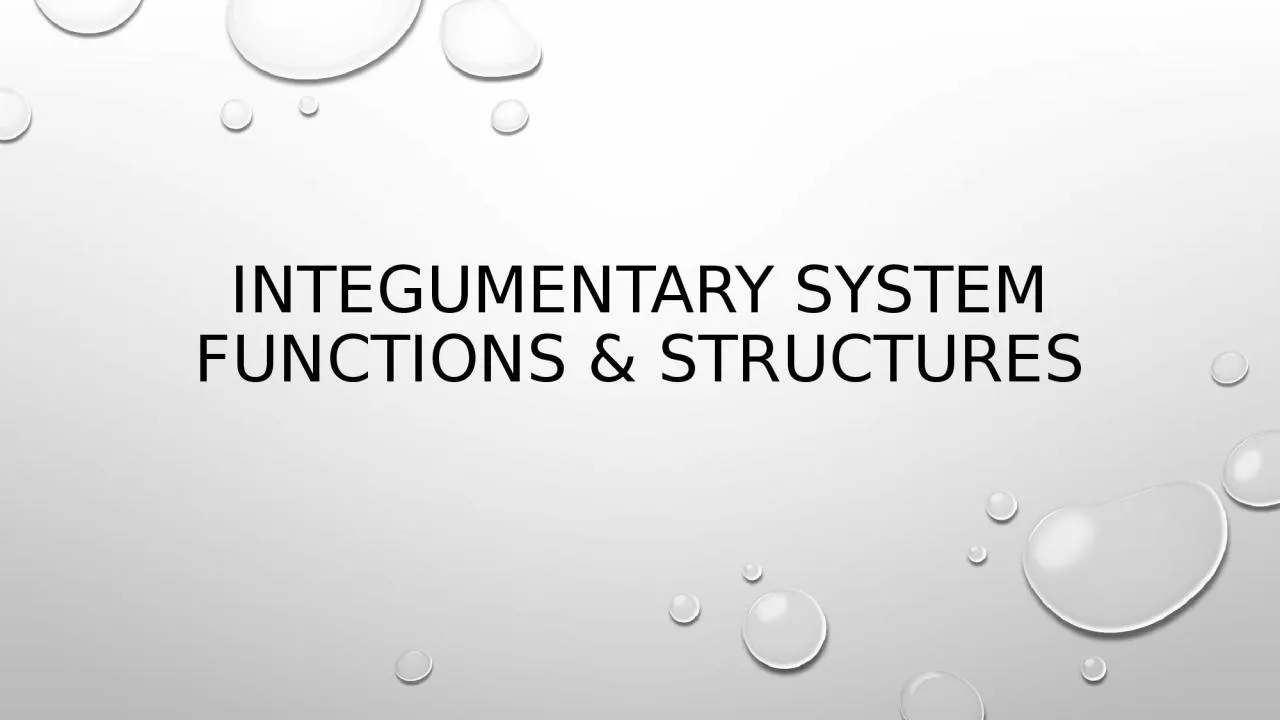

What are the functions of the integumentary system Protection Sensory Perception Body temperature regulation Storage Absorption Excretion Production protection barrier to the suns UV rays amp invasion of pathogens ID: 933652
Download Presentation The PPT/PDF document "Integumentary System Functions & str..." is the property of its rightful owner. Permission is granted to download and print the materials on this web site for personal, non-commercial use only, and to display it on your personal computer provided you do not modify the materials and that you retain all copyright notices contained in the materials. By downloading content from our website, you accept the terms of this agreement.
Slide1
Integumentary System Functions & structures
Slide2What are the functions of the integumentary system?
Protection
Sensory Perception
Body temperature regulation
Storage
Absorption
Excretion
Production
Slide3protection
barrier to the sun’s UV rays & invasion of pathogens
Holds moisture in & prevents deeper tissues from drying out
Slide4Sensory Perception
Nerves in skin help us respond to pain, pressure, temperature, & touch
Slide5Body temperature regulation
Blood vessels in skin help body retain or lose heat
When they dilate (get larger), excess heat from the blood can escape through the skin
When they constrict (Get smaller), the heat is retained in the body
Sudoriferous glands also help cool the body through evaporation of perspiration
Slide6storage
Skin has tissues for temporary storage of fat, glucose (sugar), water, vitamins, & salts.
Adipose (fatty) tissues in the subcutaneous fascia is a source of energy
Slide7absorption
Certain substances can be absorbed through the skin
Examples: transdermal medicines for motion sickness, heart disease, & nicotine patches
Slide8Excretion
Skin helps body eliminate salt, waste, & excess water & heat through perspiration
Slide9production
Skin helps in the production of vitamin d by using
uv
rays from the sun to form an initial molecule of vitamin d that matures in the liver
Slide10What are the structures of the integumentary system?
Skin
Hair
Nails
Glands
Slide11Skin
3 main layers of tissue make up the skin
Epidermis
Dermis
Subcutaneous fascia
or Hypodermis (
Subq
)
Slide12Epidermis
Outermost layer of skin
Made of 5 smaller layers, contains no blood vessels or nerve cells.
The 2 main layers:
1.
Stratum
corneum
- outermost layer
2.
Stratum
germinativum
– innermost layer
Cells from the S.
corneum
are constantly shed and replaced by new cells from the S.
germinativum
Slide13Slide14Dermis
Also called corium or “true skin”
Made of elastic connective tissue
It contains: blood vessels, lymph vessels, nerves, involuntary muscle, glands, and hair follicles.
Top of the dermis is covered with papillae (ridges) which fit into the epidermis. These ridges form lines (striations) on the skin. What do we call these striations?
Fingerprints and Footprint
s
Slide15Slide16Subcutaneous fascia-hypodermis
Innermost layer of skin
Made of elastic and fibrous connective tissue and adipose tissue
It connects the skin to underlying muscles
Slide17Glands
2 main types of glands
1.
Sudoriferous
– sweat glands; coiled tubes that come through the dermis and open on the surface of skin at pores.
Sweat (Perspiration) contains water, salts, and body wastes.
It is odorless until it mixes with bacteria on the skin = body odor
Perspiration removes excess water from the body and cools the body as the sweat evaporates into the air
Slide18Glands
2.
sebaceous
– oil glands; open onto hair follicles.
Produce sebum – oil that keeps skin and hair from becoming dry and brittle
Sebum is slightly acidic and acts as an antibacterial and antifungal to help prevent infections.
When an oil gland becomes plugged, the accumulation of dirt and oil results in a blackhead or pimple
Slide19Slide20Hair
Hair protects the body and covers all surfaces except for the palms and soles
3 parts of a hair
1. root
2. follicle-hollow tube where the root grows
3. shaft-only visible part of the hair
Slide21Slide22Hair
Alopecia- (baldness) permanent hair loss on the scalp. Due to genetics, can happen in males and females
Slide23nails
Protect the fingers and toes from injury
Made of dead, keratinized epidermal epithelial cells
Cells are packed closely together to form a thick, dense surface
Formed in nail beds
If lost, nails will regrow if the nail bed isn’t damaged
Slide24